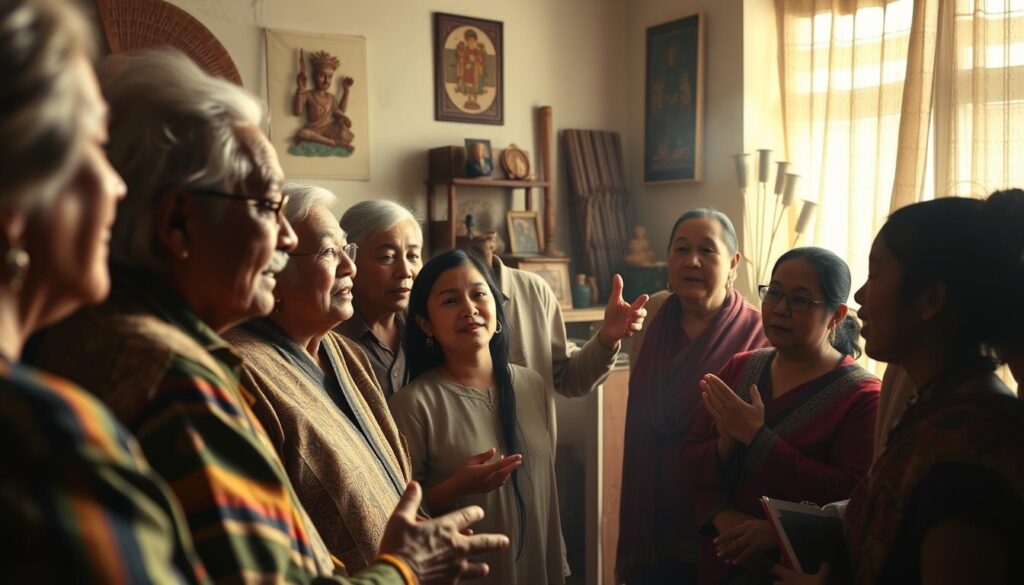Lost Languages Rediscovered Fascinating Stories
Lost Languages Rediscovered Fascinating Stories are a special part of human history. They give us a peek into the cultures and traditions of our ancestors. It’s important to save these languages to understand our past better. Thanks to efforts in language revival, we’ve made some amazing discoveries.

Language has always been key in shaping who we are and connecting us to our roots. Finding lost languages is a big win for human creativity and our cultural variety. As we explore lost languages, we see how vital saving them is for grasping our history.
Key Takeaways
- Lost languages provide valuable insights into human history and culture
- Language preservation is essential for understanding and appreciating our cultural heritage
- Linguistic revival efforts have led to significant discoveries and a deeper understanding of lost languages
- The study of lost languages is a complex and fascinating field with many stories waiting to be uncovered
- Language plays a vital role in shaping our identities and connecting us to our heritage
- Rediscovering lost languages celebrates our shared cultural diversity and promotes a greater appreciation for language preservation
The Silent World of Lost Languages
Language extinction is a big problem that hurts not just languages but also the cultures they carry. When we explore lost languages, we see how big the loss is. Losing a language means losing a community’s history, traditions, and identity. This loss is permanent and can’t be replaced.
It’s very important to save languages. By keeping historical languages alive, we learn more about the cultures that spoke them. We also help keep cultural diversity alive, which is key for a harmonious world.
Causes of language loss include globalization, moving to cities, and the spread of dominant languages. When people move or switch to more common languages, their native tongues can disappear. But, there are efforts to save endangered languages. These include documenting languages, teaching them, and working with communities.
For example, the Ainu language in Japan and the Yuchi language in the U.S. are at risk. These languages are crucial to their communities and the world. They carry unique cultural values that we must preserve. Supporting efforts to save these languages helps keep their cultural importance alive.
Ancient Scripts That Refused to Stay Hidden
The discovery of ancient scripts has been key in bringing back historical languages. These scripts, found on old stone walls, worn parchment, or clay tablets, unlock ancient cultures. Deciphering them is hard, needing patience, dedication, and knowledge of ancient languages.
One big challenge is the lack of resources and references. But, technology has made studying ancient scripts easier. Digital tools help researchers analyze and compare scripts, leading to a deeper understanding of historical languages.
Ancient scripts are crucial for linguistic revival. They give us a peek into the past, showing us the lives, beliefs, and practices of ancient people. By studying these scripts, scholars learn more about the cultures and history behind them. This helps us appreciate and preserve historical languages, keeping them relevant today.
Some notable examples of ancient scripts include:
- Egyptian hieroglyphs, once thought unreadable
- The Linear B script, used by the ancient Mycenaeans
- The Maya script, from the ancient Maya civilization
These discoveries have revealed much about ancient languages and cultures. They also help in the revival of historical languages, allowing us to learn from and appreciate the past.
The Remarkable Story of Lost Languages That Were Rediscovered
Many languages have vanished over time, leaving only a few clues behind. Yet, thanks to scholars’ hard work, some have been found again. These tales show how crucial it is to save languages.
The Rosetta Stone is a key example. It had texts in Egyptian hieroglyphs, which were unknown for a long time. By deciphering the Rosetta Stone, scholars unlocked ancient Egyptian secrets.
Cracking the Code of Linear B
Another big breakthrough was understanding Linear B. This script was thought to be unreadable. But, scholars managed to crack it, revealing much about the Mycenaeans.
The Renaissance of the Maya Script
The Maya Script is another lost language found again. It was used by the Maya. Its discovery has deepened our knowledge of Maya culture and history. The Maya Script is still a focus of study and research today.
These stories underline the value of saving languages and finding lost ones. They also show the skill and commitment of scholars. They work tirelessly to understand languages like the Rosetta Stone, Linear B, and Maya Script.
Modern Technologies Unveiling Ancient Voices
Modern tech is changing how we save languages, letting us study ancient ones like never before. High-resolution scanning and artificial intelligence help scientists read and understand old texts and inscriptions. This is a big deal for saving languages.
It helps us find and save endangered languages, which are key to our cultural heritage. With these new tools, researchers can make detailed records of these languages. This includes their grammar, words, and how they’re put together.
Some important tech in this field includes:
- Machine learning algorithms to analyze and interpret large datasets of linguistic information
- High-performance computing to simulate and model complex linguistic phenomena
- Virtual reality and augmented reality to create immersive experiences for language learners and enthusiasts
These tools help save languages and find new ones. For example, machine learning algorithms have helped uncover unknown languages. This gives us new insights into human language history.
As we explore more with modern tech, we might learn even more about ancient languages. This will help us understand human cultural heritage and why saving languages is so important.
Hidden Messages in Cave Walls and Clay Tablets
Exploring the secrets of ancient civilizations is a thrilling journey. Ancient writing systems are especially captivating to historians and archaeologists. Discoveries in cave walls and clay tablets have uncovered hidden stories and myths from the past.
Recent archaeological breakthroughs have helped researchers understand these ancient texts. They reveal the cultures and traditions of long-lost eras. By studying the language and symbols, experts can piece together the lives of our ancestors.
Deciphering the Code
Figuring out the age of ancient languages is a challenging task. It requires knowledge of language evolution, cultural context, and historical events. Researchers use methods like radiocarbon dating and paleography to verify the age and authenticity of texts.
Uncovering the Past
Some notable ancient writing systems include:
- Mesopotamian cuneiform
- Egyptian hieroglyphs
- Mayan script
These systems have given us a lot of insight into ancient cultures. They reveal their mythological beliefs and daily lives.
By studying these ancient texts, we learn more about our shared human history. It helps us understand the complexities of ancient civilizations.
Cultural Impact of Language Rediscovery
Language rediscovery deeply affects communities, helping them connect with their roots. It brings back a language, which can make a community stronger. This effort also helps keep a community’s history, customs, and values alive.
Research shows that bringing back a language can improve a community’s social and economic life. For instance, the Hawaiian language’s revival has saved Hawaiian culture and boosted tourism. The Welsh language’s comeback has also promoted Welsh culture and identity.

The good things about language rediscovery are many. Some key benefits include:
- Promoting cultural diversity and language preservation
- Encouraging community involvement in language and cultural activities
- Supporting education and economic development
- Helping to preserve history and cultural heritage
In summary, language rediscovery has a big cultural impact on communities. It’s crucial to support language preservation and community involvement to keep languages and cultures alive for the future.
Preserving Languages in the Digital Age
Technology has made it easier to save languages. Digital archives help store and protect language data. This makes it simple to share and access. Community support is key in keeping languages alive.
Modern teaching methods, like online courses and apps, help people learn endangered languages. Language preservation is a team effort. It needs communities, organizations, and individuals working together. This way, we can keep languages and cultures alive for the future.
Here are some examples of digital archives and language preservation efforts:
- Language documentation projects, which aim to record and preserve language data
- Online language courses and tutorials, which provide accessible learning resources
- Community-based language programs, which promote language use and revival
Using digital archives, community support, and new teaching methods helps save languages. This teamwork ensures languages and cultures will thrive for generations to come.
Current Efforts to Revive Near-Extinct Languages
Reviving languages is a big task that needs a lot of work and preservation efforts from many people. Communities, groups, and individuals are all working together. They are using things like community programs, language documentation, and educational activities.
There are many efforts underway. For example, language immersion programs, cultural camps, and online courses are teaching these languages. These efforts not only help bring back the languages but also help people understand and appreciate different cultures.

Also, there are efforts to document and record these languages. This includes making audio and video recordings, creating language dictionaries, and writing grammar guides. These tools are crucial for anyone learning these languages and help keep them alive for the future.
Here are some examples of successful efforts to revive languages:
- Community-based language programs that include classes, cultural events, and planning
- Teams of language experts, community members, and organizations working together to make language materials
- Online platforms and social media groups that support language learning and cultural sharing
Conclusion: The Living Legacy of Rediscovered Languages
The rediscovered languages of the past have greatly changed how we see human cultural heritage. These old languages, once believed lost, have been brought back to life. This is thanks to the hard work of scholars and new technology.
They show us the deep history of human civilizations and how we are all connected. This is a powerful reminder of our shared past.
From the Rosetta Stone to the Maya script, finding these lost languages has given us new views of history. By keeping these languages alive, we honor our ancestors. We also make sure their stories and voices continue to inspire us today and tomorrow.
Let’s keep working to save and learn about our languages. This way, we protect the heart of what makes us human. We celebrate our differences and the common experiences that unite us.
FAQ
What makes a language “lost”?
A language is “lost” when it’s no longer spoken or documented. Its grammar, vocabulary, and pronunciation are forgotten. This can happen due to a decline in native speakers, suppression by dominant cultures, or lack of preservation efforts.
What are some common causes of language extinction?
Language extinction often results from globalization, colonization, and forced assimilation. It also happens when a language’s native speakers are displaced. Without preservation, a language can disappear.
Why is language preservation important?
Language preservation is key because languages tie us to our cultural heritage and identity. Each language offers a unique view of the world. Losing a language means losing valuable cultural knowledge and perspectives.
What is the significance of the Rosetta Stone in the rediscovery of lost languages?
The Rosetta Stone, found in 1799, was a major breakthrough. It had the same text in hieroglyphic, demotic, and Greek scripts. This allowed scholars to decipher the hieroglyphic system, revealing ancient Egyptian language and culture.
How did the deciphering of Linear B help reveal the Mycenaean civilization?
The deciphering of Linear B in the 1950s was a big breakthrough. It showed that Linear B was an early form of Greek. This gave insights into the Mycenaean civilization, including its politics, economy, and culture.
What role have modern technologies played in the rediscovery of lost languages?
Modern technologies have changed language rediscovery. Tools like advanced imaging, artificial intelligence, and digital archives help scholars analyze ancient scripts. They uncover hidden messages and preserve endangered languages.
How can community involvement contribute to the revival of endangered languages?
Community involvement is vital for reviving endangered languages. Local communities can teach the language to younger generations. They can also create educational resources and promote cultural traditions, ensuring the language’s survival.
What are some current initiatives aimed at reviving near-extinct languages?
Many initiatives worldwide aim to revive near-extinct languages. These include language immersion programs, language nests, digital archives, and community-driven projects. These efforts help preserve language diversity and cultural heritage.
Lost languages tell fascinating stories of cultures and histories that have faded over time. Similarly, some bizarre bans in the US reflect unexpected rules that still exist, revealing curious aspects of society and governance.
Source
https://www.cam.ac.uk/research/news/archaeologists-discover-lost-language?utm
https://www.nationalgeographic.com/adventure/article/100827-lost-language-letter-peru-science?utm
